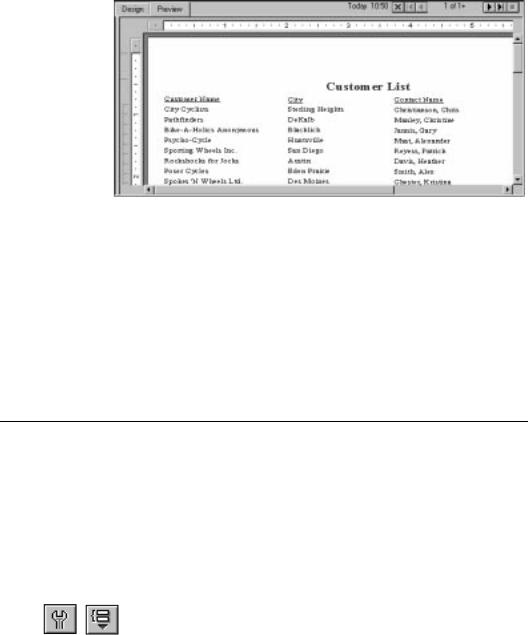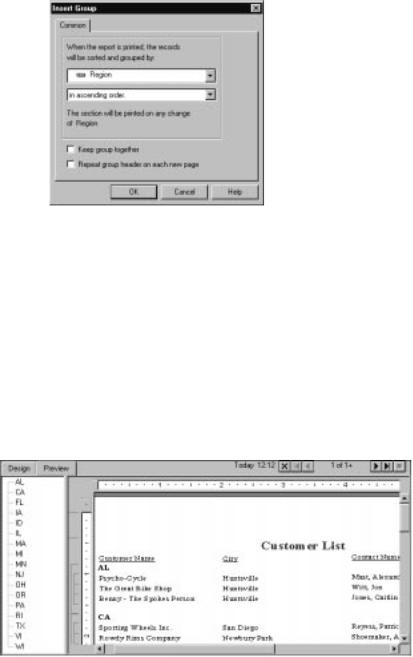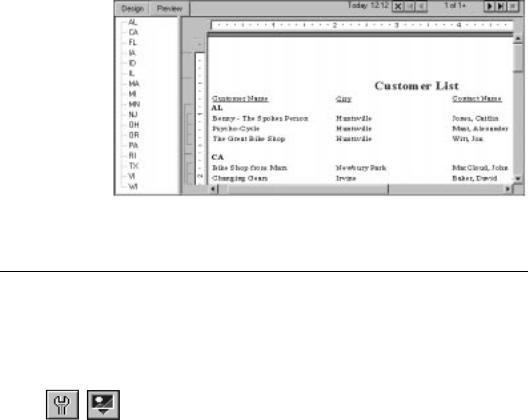
- •Welcome to Seagate Crystal Reports
- •Welcome
- •Two kinds of Hands-On tutorials
- •Command, button, key, and control conventions
- •Using Seagate Crystal Reports documentation
- •Seagate Crystal Reports online Help features
- •If you need more help...
- •Installation Requirements
- •Installing Seagate Crystal Reports
- •Installing on a network workstation
- •Upgrading from a previous version
- •Quick Start
- •Subreports expand report usefulness
- •Query Designer adds ad-hoc querying capabilities
- •Parameter fields mean multi-purpose reports
- •Text objects give you text with intelligence
- •Preprinted-form reports easier than ever
- •More powerful formulas extend your capabilities
- •Web solution serves up variety of online reports
- •HTML exporting simplifies Web activities
- •New database support improves data access
- •Running totals made easy
- •Smart Navigation
- •Learning Seagate Crystal Reports
- •User’s Guide
- •Online Help
- •Books Online
- •Sample Reports
- •Glossary
- •Sample Data - CRAZE.MDB
- •Suggested learning paths
- •The application window
- •Menu bar
- •Standard toolbar
- •Supplementary toolbar
- •Format bar
- •Status bar
- •Shortcut menus
- •Cursors
- •Design Tab
- •Preview Tab
- •Other fundamentals
- •HANDS-ON (Report Design Environment)
- •How to add, delete, and move guidelines
- •How to move and position objects using guidelines
- •How to turn the grid on/off
- •How to zoom your report in and out
- •How to undo/redo activities
- •How to drill down on summarized data
- •HANDS-ON (Sections and Areas)
- •How to add, delete, move, and merge sections
- •How to split and resize sections
- •Basic report design
- •How to design a prototype
- •Concepts in reporting
- •Beyond basic reports
- •HANDS-ON (Report Creation and Design)
- •How to select data and begin creating a report
- •How to add and link multiple tables
- •How to insert database fields
- •How to insert special fields
- •How to insert a page n of N field
- •How to insert text objects
- •How to use a database field in a text object
- •How to insert a picture
- •How to select, move, and resize objects
- •How to hide parts of the report
- •HANDS-ON (Finishing Your Report)
- •How to insert page headers and footers
- •How to add a title page to your report
- •How to add summary information to your report
- •Printing considerations
- •Design solutions for printing/distributing
- •Report creation checklist for distributed reports
- •Updating printer drivers
- •Report distribution
- •HANDS-ON (Distributing Your Report)
- •How to export reports
- •How to fax a report
- •How to request reports from a web browser
- •How to specify parameter field values
- •How to log on to a database
- •How to view plain HTML reports
- •Overview
- •Getting started
- •Record Selection
- •Grouping and sorting
- •Completing the report
- •Introduction
- •Working with Arbor Essbase data
- •HANDS-ON (Reporting on OLAP data)
- •How to create a cross-tab with Essbase data
- •Using multiple sections in reports
- •HANDS-ON (Multiple Section Reports)
- •How to work with text objects
- •How to create a form letter using a text object
- •How to format objects conditionally
- •How to print conditional messages in form letters
- •How to alternate background colors for rows
- •How to eliminate blank lines
- •How to add blank lines conditionally
- •Formatting concepts
- •Absolute formatting
- •Types of formatting properties
- •Conditional formatting
- •HANDS-ON (Absolute Formatting)
- •How to add color, shading, and borders
- •How to add/edit lines and boxes
- •How to change margins
- •How to add/delete white space between rows
- •How to set page orientation and paper size
- •HANDS-ON (Conditional Formatting)
- •How to flag values that meet certain conditions
- •Record selection
- •Group selection
- •Record selection formula templates
- •HANDS-ON (Record and Group Selection)
- •How to create a record or group selection formula
- •How to use record/group selection templates
- •How to select the top or bottom N groups
- •Sorting, Grouping, and Totalling Overview
- •Creating custom groups
- •HANDS-ON (Sorting, Grouping, and Totalling)
- •How to do a single field sort
- •How to do a multiple field sort
- •How to group data
- •How to sort records within groups
- •How to summarize grouped data
- •How to subtotal grouped data
- •How to sort based on summarized group values
- •How to create multiple levels of subtotals
- •How to group data in intervals
- •How to calculate a percentage of the grand total
- •How to create group headers
- •What are formulas?
- •Other formula conventions
- •Formula syntax
- •How formulas are evaluated - Order of precedence
- •HANDS-ON (Formulas 101)
- •How to insert a formula in your report
- •How to delete formulas from your report
- •How to copy formulas from online Help
- •How to copy formulas from one report to another
- •How to create if-then-else formulas
- •How to format text with formulas
- •How to use variables in formulas
- •How to declare a variable
- •How to assign a value to a variable
- •How to conditionally assign values to variables
- •How to use an array in a formula
- •How to use a range in a formula
- •How to use semicolons in formulas
- •How to fine tune group selection formulas
- •How to fine tune record selection formulas
- •How to debug a formula
- •Introduction
- •HANDS-ON (Advanced Totalling)
- •How to maintain running totals in a list
- •How to subtotal running totals within groups
- •How to subtotal without grouping
- •How to subtotal true A to B, A to C reports
- •Parameter field objects overview
- •Multiple parameter fields
- •Parameter field considerations
- •HANDS-ON (Parameter Field Objects)
- •How to create a parameter field
- •How to use a parameter field in a formula
- •How to respond to parameter field prompts
- •How to use wildcards with parameter fields
- •How to set a report title using parameter fields
- •How to set sort order using parameter fields
- •Graphing Overview
- •Choosing a graph or chart type
- •Where to place your graph
- •Data you can graph on
- •Before you create your graph
- •HANDS-ON (Graphing)
- •How to graph on a summary or subtotal field
- •How to graph on a details field
- •How to graph on a formula field
- •How to graph on cross-tab summaries
- •How to edit graphs using PGEditor
- •How to use the underlay feature with graphs
- •OLE Objects Overview
- •Inserting OLE objects in your reports
- •Linked vs. Embedded Objects
- •The dynamic OLE menu commands
- •OLE and the Picture command
- •General OLE considerations
- •HANDS-ON (OLE Objects)
- •How OLE objects are represented in your report
- •How to use OLE - General Overview Tutorial
- •How to insert a graphic/picture as an OLE object
- •What are subreports?
- •Unlinked vs. linked subreports
- •How subreport linking works
- •HANDS-ON (Subreports)
- •How to insert a subreport
- •How to preview your subreport
- •How to combine unrelated reports using subreports
- •How to use subreports with unlinkable data
- •Cross-tab overview
- •Cross-tab components
- •HANDS-ON (Cross-Tab Objects)
- •How to create a cross-tab object
- •How to format a cross-tab
- •How to print cross-tabs that span multiple pages
- •The Crystal Query Designer
- •HANDS-ON (Queries)
- •How to create a new query
- •How to add tables to a query
- •How to link tables and specify a join type
- •How to add fields to a query
- •How to identify unique values in a query
- •How to summarize data with aggregate functions
- •How to sort records according to field values
- •How to specify records to be included in a query
- •How to select groups to be included in a query
- •How to create an SQL expression
- •How to create a query from another Crystal Query
- •How to select a query for a report
- •How to use a parameter field in a query
- •Dictionaries Overview
- •HANDS-ON (Dictionaries)
- •How to create a new dictionary
- •How to add a data file
- •How to open an SQL or ODBC data source
- •How to link multiple tables
- •How to select tables and fields for users
- •How to add/create formulas
- •How to move fields/field headings within the list
- •How to update the location of a database table
- •How to add a new field heading
- •How to add Help text
- •How to add a graphic
- •How to create sample data for users to browse
- •How to edit an existing dictionary
- •How to convert a 3.x or 4.x dictionary file
- •How to select a dictionary for a report
- •Databases Overview
- •For additional information
- •HANDS-ON (Working With Databases)
- •How to open Access queries through DAO
- •How to open Access queries through ODBC
- •How to open Access parameter queries
- •How to set up an ODBC data source
- •How to check settings for an ODBC data source
- •How to log on to an ODBC data source
- •How to add an ODBC database table to a report
- •How to log on to MS SQL Server via ODBC
- •How to log off an ODBC data source
- •How to set up an A to B, A to C link
- •How to edit an SQL query
- •How to use an ACT! database
- •How to open the NT Event Log
- •Introduction
- •Four types of data
- •Direct access database files
- •ODBC data sources
- •Crystal Query Designer files
- •Crystal Dictionary files
- •Multi-pass reporting
- •Product support
- •Web support
- •E-mail support
- •Fax support
- •Telephone support
- •Extended technical support policy
- •Product registration
- •Product return policy
- •Product replacement policy
- •Glossary

Your report should look similar to this:
The spacing between the fields is much better, but it looks as if the report title is off center.
" Click the report title object to select it.
#Position the cursor on the right handle of the object until the cursor turns into a resizing cursor. Drag the right edge of the object frame until it is even with the right edge of the data in the Contact Name field object.
The report title automatically recenters itself based on the size of the object.
Grouping and sorting
Grouping your report
Reports can be grouped and sorted in a variety of ways. Sorting and grouping tools provide you with a great deal of flexibility for customizing your reports.
In many reports you need to break your data into groups to make it easier to read and understand. Seagate Crystal Reports lets you do this easily. For this customer list, you will group the customers by region and then sort the customers alphabetically within each group.
In the Design Tab, click the INSERT GROUP button on the supplementary toolbar. The Insert Group dialog box appears.
186 |
Seagate Crystal Reports User’s Guide |

Select the Region field from the Customer table in the first drop-down box. The program will now take all records with the same value in the region field and place them together in a group on your report.
!Select in ascending order from the second drop-down box. The region grouping will be displayed on your report in alphabetic ascending order.
"Click OK.
Notice that two new sections now appear in the Design Tab: GH1 (Group Header) and GF1 (Group Footer). This is how the program shows that the report has been grouped.
# Click the Preview Tab to see what your report looks like.
Tutorial - Customer List |
187 |

Understanding
“live” group headers
Sorting records
$If the group tree is not visible, click the TOGGLE GROUP TREE button on the format bar to see the groups included in the report.
You can view the group of interest by simply clicking on the group name in the Group Tree. For example, if you would like to see the Texas customer group, simply click TX in the Group Tree. The program will jump to the Texas group, displaying that group in the Preview Tab. The Group Tree allows you to quickly jump to a specific group of interest instead of scrolling through your report looking for the group. For more information on the group tree, see Group Tree view, Page 74.
NOTE: For many of your reports you will want to insert summaries, subtotals and grand totals. For example, if you were creating a sales report rather than a customer list, you would want to calculate the total sales amount for each region. See Sorting,
Grouping, and Totalling, Page 271.
When you insert a group, a group name field is automatically inserted in the Group Header section of your report. The group name field displays the current group’s name. For example, if you group by region, when you preview your report, the group header for the CA (California) group will show “CA”.
The group field name is automatically formatted to stand out from the records in the group.
In a typical customer list report, customer names are listed alphabetically. In this example, you will sort the customer names alphabetically within each region.
In the Preview Tab, click the SORT ORDER button on the standard toolbar. The Record Sort Order dialog box appears.
188 |
Seagate Crystal Reports User’s Guide |

●The Report Fields box lists all fields currently on your report. You can choose to sort based on any of these fields.
●The Sort Fields box displays the fields that are already sorted in the report. Because the region field is already sorted, the sorting you are about to do will be within each region, not for the entire report.
Highlight the Customer Name field and click the Add button.
Notice that the Customer Name field now appears in the Sort
Fields list box.
!Click the Ascending option button for the Sort Direction and click OK.
Your report should now look similar to the following:
Notice that the records within each group are in alphabetic order.
Completing the report
Inserting a company logo
You have just one step left to complete your report. You are going to add a company logo on the first page of the report.
In this section, you will place a company logo at the top of the first page of your report.
In the Design Tab, click the INSERT PICTURE button on the supplementary toolbar. The Open dialog box appears.
Tutorial - Customer List |
189 |

Choose the CRAZEC.BMP file and click Open. An object frame appears as you move the cursor over your report. The object frame represents the logo you will place.
!Position the object frame in the upper left-hand corner of the Report Header (RH) section of your report and click once.
Placing the logo in the Report Header (RH) section ensures that the logo is printed only on the first page of your report. See
Area printing characteristics, Page 69.
NOTE: Although there does not appear to be enough room in the Report Header (RH) section when you place the graphic, the section will automatically expand to accommodate the picture.
"Click the Preview Tab to view your report. Your final report should look like this:
#Save your report by clicking on the SAVE button on the standard toolbar.
You have just completed your first report. It is a pretty impressive report, and Seagate Crystal Reports made it easy to do.
Related Topics
For information about distributing your report (printing, exporting, etc.) see Printing, Viewing, and Exporting, Page 135.
190 |
Seagate Crystal Reports User’s Guide |

8 |
Reporting on OLAP data |
What you will find in this chapter...
Introduction, Page 192
Arbor Essbase client drivers, Page 193
Selecting members for dynamic reporting, Page 193
Combining data using subreports, Page 195
Essbase database security, Page 196
The report definition and the Essbase outline, Page 197
Storing database outlines, Page 198
Saving reports without outlines, Page 198
Server independence of reports, Page 199
Updating Essbase server and database locations, Page 200
Efficient access of Essbase databases, Page 201
Optimizing for large Essbase databases, Page 201
HANDS-ON (Reporting on OLAP data), Page 202
Reporting on OLAP data |
191 |
